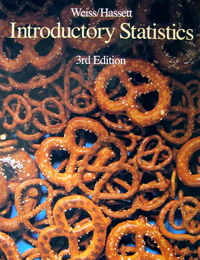 Authors: Neil A. Weiss and Matthew J. Hassett
Authors: Neil A. Weiss and Matthew J. Hassett
Started: 16 Jan 2006
Finished: 7 Mar 2006
940p / 51d
18 p/d
After starting my new job, I decided a review of statistics might be in order, just to make sure I remembered all the relevant terminology and such and had the concepts fresh in my mind. I don’t actually have to DO that kind of analysis for work right now, but I certainly have to understand it. So review is good. It has been a long time since I’ve had to do this kind of stuff.
Now, I dug this particular book up from college days. Specifically the one summer between undergrad and my one abortive year of grad school. Even though I had a Physics degree, the Heinz schoiol required an actual stats class as a pre-requisite. I had used lots of stats, but never taken an actual stats class. So I signed up at the community college over the summer. There was all kinds of confusion about if I was an in state student or not and what the price was and all kinds of other things. Anyway, as it ended, although I attended all the classes, I never was officially enrolled in the class, never paid, and never got any official credit for it, and Heinz did not care and I started anyway. The class was also painfully simple. I was very bored.
In any case… the book… like the class, the whole first half of the book is painfully slow. There are chapters spent on what Means and Medians are, which arer topics Amy covered in the first half of 5th grade… I know it started at the beginning, but… so anyway it slowly gathered steam. Only the first few chapters were truly trivial. Then there were many chapters of stuff I remembered once I read it, but would have been challenged to describe cold if asked before I read the book. Then maybe the last half of the book was actually stuff I didn’t remember at all.
It frustrated me though. Not because the material was hard, but because it was all being done as a cookbook approach. “Have this kind of problem, use this procedure.” There was no derivation from first principals, and in many cases they avoided actual equations whenever possible. And there were bunches of places where if they had used calculus it would have been a lot nicer, but they were doing this at a level where algebra was enough. Now, I understand, this is the kind of bpook this is. This is a stats literacy book, not a book for math majors. So no proofs. No derivations. No detailed analysis of WHY something is done the way it is… it is just given as fact. Which has its purposes, but that always tends to frustrate me. I don’t like just being told something is some way because it is, I like to understand why.
But that would be a different textbook entirely. (And I’m not so interested that I’m going to go order one now.)
This one did its job. It refreshed my memory of various sorts of statistical analysis that I might bump into or need. Enough so I can speak about such things without being a complete idiot, and enough so I know where to look for more info if I need it.
Which is good.
But after 51 days and 940 pages of a statistics textbook, I am now quite glad the book I am now reading is a nice quick read novel…
Leave a Reply
You must be logged in to post a comment.